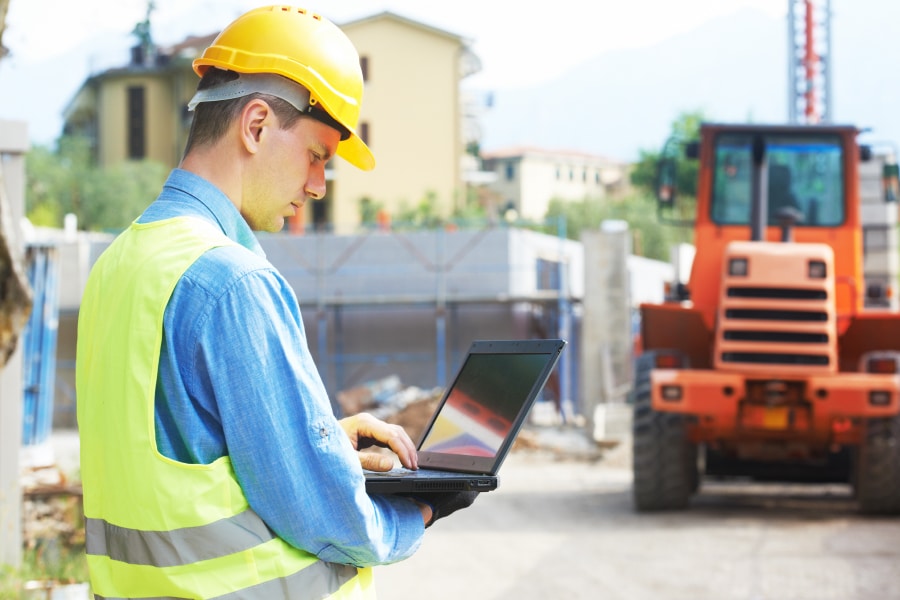When work is interrupted and shutdowns are called, those who can work remotely may be able to keep your business operating. However, as we’ve learned, they may also be juggling personal challenges (think homeschooling).
On the other side of the coin, your operational labour workforce will be battling a stop-start environment, struggling to get the right product and materials at the right time, and potentially losing income while forced to down-tools.
These ebbs and flows – alongside the challenge of keeping track of your team’s contribution, performance and sanity – mean your business will need to use a multipronged approach to managing your complete workforce.
“The events of 2020 radically accelerated the uptake of remote working for many organisations and proved that office-based staff do not need to be tethered to an on-site workplace to remain productive,” said Nick Deligiannis, Hays Recruitment managing director. “Clearly, the parameters around where work gets done have changed forever.”.
Your approach needs to reflect the spectrum of your people, including those who have to be on-site or in the office, as well as those who can complete their scopes of activities remotely.
Why should the construction industry support a transition to working from home?
Your business now has the power to short-circuit one of the most challenging parts of the workday for those who work at a desk – getting to the office.
The daily commute in our cities now takes longer. A 2019 study by the Melbourne Institute showed that the average commute time for Australians increased 23% in the 15 years prior to 2017. This study also highlights the effects longer commutes have on workers, including lower job satisfaction, decreased overall wellbeing and negative family outcomes.
Commuting aside, there are plenty of additional benefits for both you and your people as a result of remote working:
- There’s no excuse for being late, and with no commute, your staff will start the day less stressed and probably grateful for the extra time back in their day (as well as the money they’ve saved on their daily coffee stops, petrol, parking and tolls).
- Working from home also means fewer interruptions — whether it’s lunchroom gossip or ad hoc meetings, this adds to a more productive workforce.
- A workplace that offers remote working options will be more attractive to potential candidates — you are demonstrating that you are progressive and value your people.
- Your business will save money. With workforce flexibility, there are options for a smaller office footprint and the opportunity to introduce hot-desking, saving on printers and office equipment and utilities.
- Online meetings are often more purposeful — and with fewer stragglers holding up the start time, you can achieve more in less time.
Managing remote teams
The reality is a new normal is emerging, and businesses need to harness the opportunity to build an agile workforce with remote working arrangements.
Applying learnings from the COVID-19 pandemic, when future circumstances throw a spanner in your business-as-usual activities, you’ll be ready to methodically assign outstanding work that can be completed remotely to the right people.
Take the opportunity to work on tasks you’ve been avoiding and identify areas for business development that may have taken a backseat. Despite the interruptions to daily operations, you may discover the merits of empowering key staff to either work remotely on a full-time or more regular basis.
Managing those who work remotely is similar to managing dispersed teams across multiple locations. Circumstances and tasks may be a little different, but the common thread is consistent and clear communication and support with and across the team.
Five considerations to help you manage your remote workforce:
- Have a clear understanding of who can work remotely and confirm they have the tools and technology to deliver outcomes from wherever they are working.
- Ensure remote team members have a safe workspace wherever they are working and that they are supported and enabled with clear policies and processes.
- Check in formally and informally with each team member individually and a group at regular intervals.
- Use project collaboration software and meeting tools such as Teams, Zoom or Google Meet to update, keep the teamwork going and collaborate.
- Harness opportunities for team members to mentor and collaborate — consolidating your team’s morale, connectivity and performance.
Having the right tools is key to your people being able to deliver work effectively. On projects with multiple partners and contractors, software collaboration tools such as Revu will ensure everyone has the same information in real time — reducing errors and costs.
Working remotely with customers, partners and stakeholders
Not only do you have to manage your teams remotely, you and your teams need to interact with your customers, partners and other stakeholders who will also have varied work arrangements. This challenge is exacerbated by time differences, different COVID-19 operating rules across Australian states and territories, and the challenge the construction industry faces in shifting product availability nationally and internationally.
The above circumstances confirm why communication is central in managing internal and external relationships — particularly across major infrastructure projects with multiple delivery partners, including primary and subcontractors, and sometimes several clients in the broader project.
This can be a significant shift if you’re used to having weekly face-to-face meetings or travel regularly to jobsites around the country.
Suppose you’re dealing directly with communities or other private landholders for any portion of your projects. In that case, you need to consider the digital divide and whether these stakeholders can access the necessary tools to engage remotely.
Stretched networks — exacerbated by households full of remote workers and their school-aged kids competing for bandwidth — means video collaboration tools should be backed up by integrated and shareable software tools such as Revu. Embedding a centralised place to create, annotate and share documents will enable projects to always stay on track and align teams every step of the way.
Again, communication is key. Ensure your team is all working on the same platforms and that communication channels are well-defined. Communicating on multiple platforms such as email, Skype and Teams may lead to critical information being forgotten or lost. It’s time-consuming to scroll through chat lines to find information from weeks beforehand. In the case of online video meetings, stick to using one tool and save minutes and essential details on your shared collaboration platform.
Preparation is also essential for running video meetings:
- Have a clear agenda and send out supporting papers in advance
- Make sure you are well versed in how to share documents in the live meeting setting
- Keep meetings to 45 minutes or less
- Ensure all meeting participants have a purpose in attending
Agree on the “rules of engagement” in advance, such as muting your microphone when not speaking and ensuring your meeting is the sole focus of your time.
Building an effective hybrid working model
While certain jobs on a construction project can be done from anywhere, there is still the task of physically building onsite. A lot of construction work is hands-on and aside from the build itself, there are a number of roles that will require your staff to be on the jobsite with colleagues and clients alike.
You can restructure and automate many of the tasks associated with bringing a project to life, but for now, the construction industry can’t be completely remote. Site visits still need to happen, and tools still need to be used, so it’s important to create a safe and collaborative working environment for everyone.
Some companies in the construction industry are moving to hybrid working models. A hybrid workforce is split between working remotely, working in the office and a mix of both.
While hybrid working models may impact your teams’ operation and the types and scopes of projects they work on, flexibility is becoming more important.
“As we look forward, it’s clear that our places of work are more fluid than they have ever been before,” Deligiannis said.
“Our traditional workplaces have fewer people in them, as employers afford their team members the flexibility to come into the office some days, and then work the rest of the week at home. This may cause the dynamics of teams to change from one day to the next, which necessitates careful management.”
A fit-for-purpose hybrid workforce also means a shift in office spaces, with smaller footprints, but also embedding social distancing. As we move to COVID-normal, sitting shoulder to shoulder with your office coworker should be a thing of the past. New treatments to ensure some physical separation may be more than office partitions, including more greenery and flexible hot-desking solutions.
Transforming workplaces means considering the size of your office, how the space builds productivity and collaboration, and where the location of your office should be. Workers who are not office-bound have formed a large proportion of the shift to regional centres. So, as a construction business, you can consider whether your office needs to be in a CBD precinct or should you look to a more dispersed or flexible arrangement.
Developing a remote work policy
Successfully developing and navigating new working arrangements begins with the framework for both employers and employees to be clear about how work will be done.
Not all workplace issues require a policy. Many routine matters can be dealt with through simple workplace procedures and processes. However, it’s prudent to seek expert advice about ensuring your remote working policies meet the needs of your business.
Policies help you manage your staff and set out clear expectations and what happens if employees don’t comply. It also gives management a framework to operate within to do their jobs effectively. It should include eligibility, working hours, any approval processes, what equipment or resources the company will supply, what the employee needs to provide, home office setup and more. Policies should be developed in consultation with staff and alongside expert advice.
What should remote working policies include?
Who is eligible?
The reality is that many roles cannot be delivered remotely — particularly hands-on jobs in the construction industry. And while there may be a range of positions that can be delivered remotely, sometimes the arrangement is not appropriate for the individual. Consider whether those seeking to work from home are self-directed and able to work independently and if they have the right tools and technologies to complete their work effectively.
Where can they work?
For some businesses, remote workers may be anywhere in the world; for others, they need to be within a commute for critical face-to-face time. To manage risk, ensure that your policy confirms whether taking a working holiday abroad is considered an appropriate remote working location.
What are the arrangements?
Are working hours firm, or is it acceptable to take time out of the workday for a longer lunch, to run errands or go to the gym and make up the time later? If the 9 to 5 structure is firm, this needs to be articulated. If you’re embedding flexibility, ensure this also has boundaries and accountability. You will also need to articulate and support workspace requirements such as:
- What equipment and technology does your workforce need to have? Will employees need to use specialist software from home? If so, how will cybersecurity be managed?
- How is office space managed — is it a dedicated workspace or is the kitchen table appropriate? If the employee spends a significant time in online meetings, is their technology and environment suitable?
Best practice tips for setting up remote work
As the owner, manager or team leader for a new-look workforce, it may seem overwhelming to have so many changes to embed within such a short time. However, failing to make the shift will cost your business in lost productivity and opportunity.
There are a number of online resources that will help you identify what to consider and how to implement change in a way that helps future-proof your business.
Key resources can be found at:
- Safework Australia – working from home
- NSW Government – working from home guidance for employers
- Fairwork Australia – flexible working arrangements
- CCIQ – workplace policies and procedures
How do you package everything up and put it into practice?
Here are some practical tips for making remote working work for you and your teams.
- Set clear guidelines, boundaries and expectations for your team.
- Partner team members with mentors or “buddies” to build collaboration and informal accountability.
- Have a morning huddle and, when needed, an end of day debrief.
- Encourage team members to structure their time well and communicate their daily challenges.
- Have a dedicated working space so your team can ‘leave’ work at the end of the day and on the weekends.
- If everyone in your organisation isn’t working remotely, establish a robust system to keep everyone feeling connected and engaged.
- Use collaboration tools, but keep to one communication channel to ensure messages aren’t lost.
- Be accessible.
- Recognise and support those who also do not have the option to work remotely.
Hybrid working environments are here to stay. Building a workforce for the future requires a long-term focus, and optimising the possibilities while managing the risks will take time.
Learn from other businesses’ experiences, and continue to evolve and refine your business arrangements to embed remote working practices.
Consider how to connect, challenge and upskill your workforce to harness new technologies — online training and mentoring arrangements will help build your workforce capability.
Finally, you aren’t in this alone. If your business isn’t connected to an industry network, now is the time to join. Networks are critical in helping to navigate new challenges and to share experiences and learnings.











